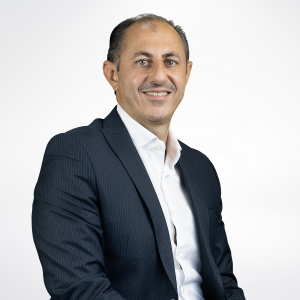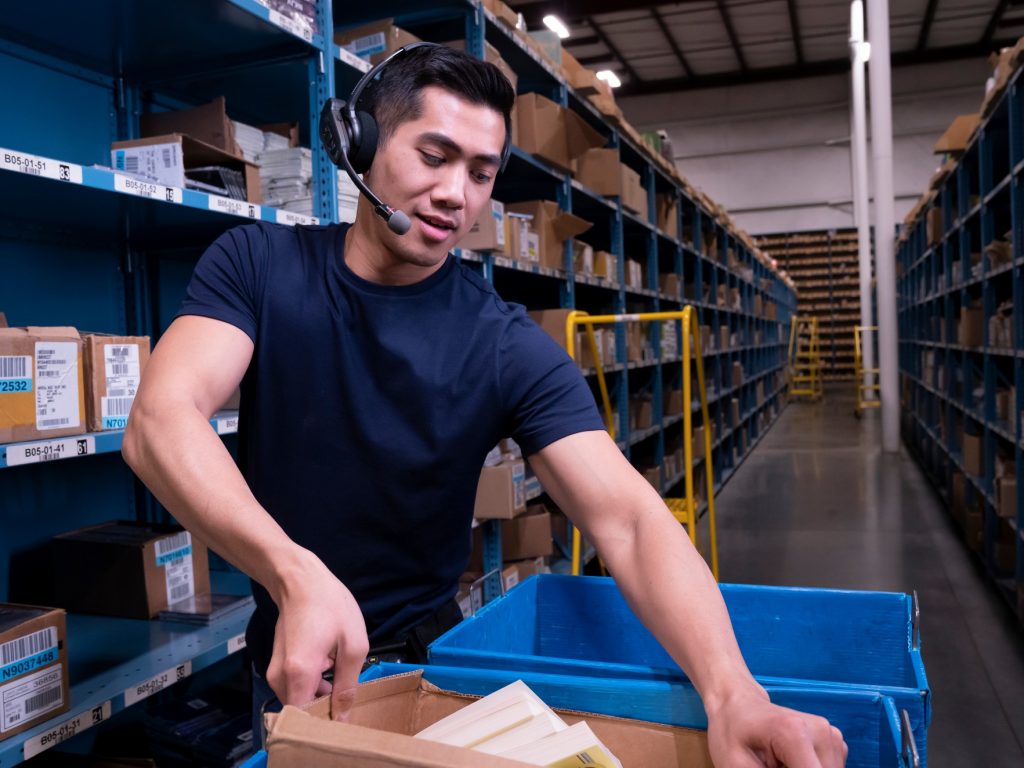Logistics News ME delves into discovering the best last-mile delivery service providers in the region in terms of efficiency, transparency, cost-effectiveness, and sustainability
Aramex Express
Alaa Saoudi, Chief Operating Officer

The growth in eCommerce sales can be attributed to the growing number of businesses with new digital business models that allow for digital payments, increasing purchasing power of customers, and the widening range of products that can be purchased online.
He adds: “Customer preferences have also shifted for instant, time-definite, seamless, and contactless deliveries with free or low shipping costs. In addition, customers also want to be in control of their own delivery experience including the ability to track deliveries in real-time, flexibility to select delivery windows, and optionality to communicate directly with the delivery driver or customer care representative.”
Scaling operations
This has pushed last-mile delivery companies such as Aramex Express to figure out how to improve their operations by scaling their capacity to keep up with the surge in demand and leveraging technologies to drive efficiencies and reduce delivery costs.
Saoudi explains: At Aramex, we have accelerated our investments towards scaling our operations to capture the strong demand and surge in eCommerce volumes. Last year, we inaugurated a new express courier handling facility at the Model Cargo Village at King Khalid International Airport.
“The new facility is equipped with the latest technologies including the latest automated parcel sorting systems with a capacity to handle more than 100,000 shipments per day. In addition, it is directly connected to the Saudi Customs Clearance systems, which will significantly reduce the time needed to clear the shipments and deliver them to their destination. We have also established two new hubs specifically in Prague to cover Europe and Accra to cover West Africa. Additionally, in Kuwait, we expanded our presence by moving to a new 12,500 sqm fulfilment centre.”
Leveraging technology
The firm has also employed technology-driven solutions such as Aramex Spot and Aramex Fleet, both of which are delivering flexible operations and scalability along with new delivery preferences for end customers.
He adds: “In addition, we are leveraging several technologies including the migration to the cloud and operation-enhancing AI technologies that optimise delivery routes and shorten delivery times.
“Our recent investments in technology, AI and analytics data adds greater visibility and predictability to our Express business, leading to greater efficiency and enhanced customer service. Of note, we teamed up with Salesforce to integrate a customised CRM system that provides us with greater access to gain a holistic view of customers across its portals, apps, and social media to offer optimised solutions.”
Aramex is also seeking ways to every mile of the delivery journey – from first to last mile – as efficient and eco-friendly as possible. “We dedicate resources – time, people, and money – to constantly innovate our operations and processes. We have a very clear roadmap for automation across all facilities in our core markets in the coming two years,” Sauodi signs off.
——————————————————————————————————————————————
DHL Express MENA
Bachi Spiga, Head of Operations

Bachi Spiga explains: “The pandemic shifted consumer demand patterns. Financial constraints and social shifts caused many consumers to re-evaluate their spending, prioritising items considered more of a necessity during a ‘stuck at home’ situation. In the Middle East, DHL saw the fastest moving product categories to be hygiene, self-care, fitness apparel, office equipment and food items.”
The insatiable rise in eCommerce has brought in a flood of new customers who are demanding to receive competitively priced shipments at their convenience. “This trend is challenging fulfilment,” discloses Spiga.
“Last mile is the most expensive and time-consuming part of the supply process, accounting for over 50% of the shipping costs, and continuous investment is necessary in technology and solutions to improve fulfilment timelines through faster and more efficient deliveries, at lower costs,” he adds.
Innovation in last-mile logistics
New last mile delivery services are inspired by the need for safe, contact-free options, and have grown in popularity due of the flexibility and convenience they offer. With customers spoilt for choice, expectations for last-mile delivery innovation remain high.
Heralding the last mile delivery revolution is technology. “Technology is crucial in driving efficiencies and curbing costs in last-mile delivery,” Spiga notes.
“From the predictive capabilities of AI and big data-analytics used to solve operational challenges and determine dynamic route optimisation, capacity accuracy, and demand prognostics; to driverless trucks, rovers, and drones which can unlock new levels of safety, efficiency, and quality in last mile delivery, the integration of latest technologies in logistics can create a more dynamic and customised delivery service capitalising on enhanced visibility, transparency, reliability, and security.”
As last mile delivery service continues to evolve, sustainability and environment-friendly practices comes to fore. Spiga says: “Sustainability gained momentum during the pandemic and has become an extremely important differentiator in logistics.
“Consumers have become more conscious of the environmental impact of their online shopping and are turning away from unsustainable brands. There is a higher expectation on the businesses they buy from, to play their part to reduce waste across their entire supply chains. Logistics is increasingly prioritising environmental operational efficiency in last-mile delivery, re-visiting the transportation sector which is one of the main causes of global carbon emissions, and adopting eco-friendly strategies to green the last mile, be it through route optimisation, electric vehicles, or localisation of warehousing, to reduce our carbon footprint while maximising efficiencies.”
Looking ahead
With technology moving at a rapid pace, DHL is focused on localised and digitised fulfilment to improve the last mile. The sky is really the limit with last-mile delivery innovation. We have seen so much development already in last-mile solutions, from robots rolling down the sidewalk, to drones and parcelcopters landing in peoples’ back yards. We are still competing on time and cost, so we need to make sure we stay agile in adjusting to market trends and we are open to learning and reinvention,” he concludes.
——————————————————————————————————————————————
FedEx Express
Taarek Hinedi, Vice President of Middle East and Africa Operations

“At FedEx, we continuously look for innovative solutions to make deliveries more flexible, convenient, cost effective, and sustainable. One example is electric vehicles. With the increase in demand for last-mile deliveries, thanks to rapid eCommerce growth, electric vehicles are now being tested and added to our fleet around the world in phases with the goal of making the FedEx pickup and delivery fleet zero–emission by 2040.”
The pandemic has fundamentally changed the way people shop for their goods, accelerating the rise in online shopping. Changes to how much and what consumers are buying online are transforming how deliveries are managed.
Rising customer demand
In 2021, consumer electronics, apparel and footwear, and F&B were the top three products in demand in the Middle East and North Africa region, according to reports. Another report states that, during the same year, the demand for smartphone in India increased with 5G shipments registering a growth of 555% year-on-year.
Increasing demand is driving delivery companies to consider how they can become more efficient, while growing environmental concerns are increasingly influencing consumer purchasing decisions.
He adds: “Globally millennials are choosing alternatives to home delivery on account of environmental concerns. Alternative pick-delivery solutions such as ‘hold at location’ or parcel lockers are becoming increasingly popular worldwide alongside innovative solutions such as zero tailpipe emission delivery robots and electric vehicles as companies look at environmentally sustainable transport options.”
Every aspect of commerce is undergoing radical change and businesses are demanding greater control, flexibility, and visibility across their supply chains. Delivery companies are looking at new business models to operate more efficiently, while meeting the increase in demand for last-mile deliveries.
Hinedi explains: “We’ve seen an exponential growth in eCommerce and the long-term shift that’s affected buying behaviour and how companies think about logistics. And, at the same time, with the advancement of logistics technology, supply chains are creating increasingly more data.
“Today’s economy is rooted in the transfer and availability of information that moves things forward. Having real-time insights about supply chain decisions better informs how we can adapt to new and unexpected challenges. But with new tools now at our disposal…the possibilities may very well be limitless.”
As technology evolves, so does its application. The transportation industry will see benefits of next-generation innovation for team members and operations, including computer-assisted vehicles, artificial intelligence, robotics, and drones.
“These new technologies and innovations to use, and using data to inform future change, both in how we interact with packages travelling through the system and create and maintain more efficient supply chains will shape the future of last-mile deliveries,” he says.
——————————————————————————————————————————————
Honeywell
Roman Poludnev, General Manager – Safety and Productivity Solutions for Middle East, Russia, Turkey, and Africa

As eCommerce continues to grow, last-mile delivery is being pushed to limits with challenges like limited public space, traffic congestion, shorter delivery windows and road safety. With just a few clicks, a consumer is given a day and time for home delivery.
Roman Poludnev says: “For last-mile delivery, the last-click begins a symphonic production consisting of countless digital algorithms, resources, and people to deliver on consumer expectations to have the parcel delivered to their doorstep.
“Consumers expect real-time visibility over their orders. They want to see where the driver is at any given time and exactly when the parcel will be delivered. They expect the delivery when it was promised. Delivery delays can cost brands their reputation, loss of customers and return business. This is where online customer loyalty is won or lost.”
Advanced technology adoption
He notes that since 2020, how the industry has seen “home delivery go from nice-to-have to essential”. “In a very short time, there have been changes to delivery processes that have been in place for years and rapid adoption of new technologies.”
Poludnev maintains that as eCommerce grows, delivery service operators know that their share of the competitive landscape depends on their ability to fulfil customer expectations in areas of same and next-day delivery, offering a wide range of convenient delivery windows, accurate estimated time of delivery, as well as efficient and timely communications.
He adds: “Technology plays a huge role in helping compete and perform at or above customer expectations. For instance, Honeywell’s comprehensive solution for entire supply chain ensures products and packages are trackable and traceable throughout the supply chain – a critical requirement when it comes to products such as pharmaceuticals, vaccines and for the food and tobacco industries. Track and Trace is a software solution that provides real-time visibility and reporting of products within a vehicle, a container, a pallet, or a packaging box at the micro-level, enabling users to track products throughout the supply chain.”
Industries that have been challenged by the economic impact of the pandemic are rebuilding with a focus on resilience. “This is creating opportunities for optimisation and efficiency while furthering the digitalisation of the sectors, which we are enabled through Honeywell’s advanced technologies,” he expresses.
Sustainable practices
Advanced technologies are also helping companies to implement environment-friendly measures. Honeywell’s Voice Guided Work enables operations to efficiently handle eCommerce volumes, speeds, complexity and collaboration within warehouse and distribution centres. It also enables sustainable practices. Using a hands-free system, Voice Guided Work cuts back on paper waste.
“Providers must meet or exceed the service needs of customers both in ways they expect, and in ways they have not yet imagined. This includes collaboration throughout the process and making a clear commitment to sustainability. To this end, Honeywell has made a commitment to drive sustainability in all aspects of business,” Poludnev says.
——————————————————————————————————————————————
noon
Ammar Tambawala, VP Ops Strategy

Ammar Tambawala explains how the pandemic has impacted noon’s last-mile delivery in the last two and a half years. “We have seen an uplift in two key areas: safety, and demand. The demand for silent, contactless deliveries increased significantly, providing a safer experience for both noon’s customers and delivery team. We were able to match the increase in online purchases after travel restrictions were lifted by increasing the scope and efficiency of our last-mile fleet.”
Challenges and hurdles
This hasn’t come around without its fair set of challenges. “A key focus is on increasing the efficiency and productivity of our last-mile fleet in order to meet customer demand at a sustainable rate for delivery associates,” he says.
“The global supply chain crisis is putting a strain on vehicle lead times and availability, and rising cost inflation (fuel prices) has been a strain on the industry. We’re addressing these issues through smarter operational planning.”
Technology plays a crucial role in helping last-mile delivery service providers such as noon to overcome these challenges. Tambawala notes: “A robust technological network is essential for effective last-mile delivery operations. Accurate address codes, smart location tracking, route optimisation, and high-frequency order updates have all contributed to smoother deliveries. This has allowed us to define optimal delivery clusters and delivery path optimisation, as well as improve our customer experience and expectations.”
noon is also invested in ensuring its last-mile delivery services are more efficient while following sustainable practices. “Our ‘Get It Together’ mode allow customers to receive multiple packages in a single delivery, reducing fuel consumption and increasing productivity,” he reveals. “Allocation of click and collect lockers at multiple convenient touchpoints, more compact and reusable packaging are also important in decreasing our footprint.”
Future focused
Looking forward noon anticipates a significant increase in delivery volumes as the eCommerce industry expands. “Our primary focus will be on scaling up efficiently and sustainably to meet this demand. Consumer expectations have shifted dramatically, and we anticipate an increase in demand for faster deliveries, particularly in the Q-commerce space,” Tambawala says.
He concludes: “noon’s fastest delivery service, noon in minutes, now offers customers in select parts of Dubai an assortment of thousands of products delivered in just 15 minutes.”
——————————————————————————————————————————————
Shipa Delivery
Borhene Ben Mena, CEO

Borhene Ben Mena believes that urbanisation, eCommerce, and digitalisation have had a major impact on last-mile delivery in the last five years. He explains: “The rate of movement of people from rural areas into cities has continued to grow, despite being slowed for a period by the pandemic. The continual increase in consumer density has piled pressure on infrastructure and resources and challenged supply chain managers to devise new ways to fulfil and deliver orders to end consumers.”
He adds: “The pandemic drove traditional brick-and-mortar shoppers to online shopping channels, giving them a taste of the ease of eCommerce. For many, online shopping has now become the preferred way of buying products and are flocking to eCommerce channels in droves. The increased demand for home deliveries means shippers must significantly boost their fulfilment and last-mile delivery processes.
“With Amazon, Uber, and fast-food delivery firms offering a slick user experience, customers are expressing frustration at the slower standard of service offered by traditional delivery carriers. If they have a choice, they opt for tech-savvy companies that offer faster delivery. They are also demanding additional features such as selection and modification of delivery windows and tracking deliveries in real-time.”
eCommerce a boon or a bane?
eCommerce is spurring retail growth globally. “The demand for last-mile delivery services is exploding—luring many new players into the industry and spurring many companies to offer omnichannel services,” Mena adds.
“Consequently, the last-mile delivery sector has also grown across the board. The biggest boom has been in the expected industries—food and groceries, apparel, and furniture—but also in less-expected industries such as pharmacies, banks, tobacco, coffee, luxury goods, and accessories.”
Like consumers around the world, GCC clients have become used to the luxury of shopping from home and getting what they need, or fancy delivered in the shortest possible time.
This surge in eCommerce has had its pitfalls: rise in global carbon emissions. “Customers are seemingly oblivious to the fact that the single-item delivery they are demanding is the most polluting leg of last-mile delivery.
“Fortunately, more and more consumers are considering environmental and health concerns when buying products online. They are also becoming more ecologically conscious, with more than half of millennials citing protection of the environment as the reason for choosing alternatives to home delivery.”
However, if eCommerce grows at the galloping rate that economists are predicting, a whopping 36% more delivery vehicles globally will be weaving in and around inner-city streets by 2030, increasing congestion and adding to carbon emission levels, Mena discloses.
“To mitigate some of this choking carbon footprint, responsible last-mile delivery companies are investing in greener modes of transport, including electric vehicles, eScooters, and electric bicycles,” he adds.
“Other innovations include establishing parcel lockers for the self-service collection of parcels, coordinating with other companies to improve load pooling, using AI for efficient real-time route optimisation, buying local, and tightening up returns policies by limiting the number of sizes and colours of the same item customers are allowed to order.”
Mena believes that robotic delivery and drone delivery are going to revolutionise the shipping process. He concludes: “The cost of labour for last-mile delivery is approximately 60% of the overall delivery cost. By implementing robotic and drone delivery, companies will save costs. At the same time, implementing more automatic processes will keep workers safer.”
——————————————————————————————————————————————




